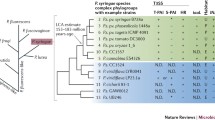Abstract
The majority of pathogenic strains ofPseudomonas syringae produce the phytotoxin syringomycin. After treatment ofP. syringae with acridine organe, some surviving isolates were unable to produce the toxin or disease in maize plants. DNA analysis of strain HS191 revealed the presence of a single, 35-megadalton plasmid, designated pCG131; no detectable plasmid was seen in the cured derivative. Comparative studies with the parent and cured strains showed an association between the presence of the plasmid and the following properties: syringomycin production, resistance to bacteriocin PSC-1B, and resistance to phages Psp1 and Psy4A.
Similar content being viewed by others
Literature Cited
Asheshov, E. C. 1975. The genetics of tetracycline resistance inStaphylococcus aureaus. Journal of General Microbiology88:132–140.
Backman, P. A., DeVay, J. E. 1971. Studies on the mode of action and biogenesis of the phytotoxin syringomycin. Physiological Plant Pathology1:215–233.
Bobrowski, M. M., Matthew, M., Barth, P. T., Datta, N., Grinter, N. J., Jacob, A. E., Kontomichalou, P., Dale, J. W., Smith, J. T. 1976. Plasmid-determined β-lactamase indistinguishable from the chromosomal β-lactamase ofEscherichia coli. Journal of Bacteriology125:149–157.
Clowes, R. C. 1972. Molecular structure of bacterial plasmids. Bacteriological Reviews36:361–405.
Curiale, M. N., Mills, D. 1977. Delection and characterization of plasmids ofPseudomonas glycinea. Journal of Bacteriology131:224–228.
Currier, T. C., Nester, E. W. 1976. Isolation of covalently closed circular DNA of high molecular weight from bacteria. Analytical Biochemistry76:431–441.
Gonzalez, C. F., Vidaver, A. K. 1977. Syringomycin and holcus spot of maize: Plasmid associated properties. Proceedings of the American Phytopathological Society.4:107.
Gonzalez, C. F., Vidaver, A. K. 1979. Analysis of plasmids of syringomycin-producing strains ofPseudomonas syringae. In: Proceedings of the IVth International Conference on Plant Pathogenic Bacteria, Angers, France (August 22-September 2, 1978). In press.
Gonzales, C. F., Vidaver, A. K. 1979. Bacteriocin, plasmid and pectolytic diversity inPseudomonas cepacia of clinical and plant origin. Journal of General Microbiology110:161–170.
Gross, D. C., DeVay, J. E. 1977. Population dynamics and pathogenesis ofPseudomonas syringae in maize and cowpea in relation to the in vitro production of syringomycin. Phytopathology67:475–483.
Gross, D. C., DeVay, J. E., Stadtman, R. H. 1977. Chemical properties of syringomycin and syringotoxin: Toxigenic peptides produced byPseudomonas syringae. Journal of Applied Bacteriology43:453–463.
Gross, D.C., DeVay, J. E. 1977. Production and purification of syringomycin, a phytotoxin produced byPseudomonas syringae. Physiological Plant Pathology11:13–28.
Guerry, P., LeBlanc, D. J., Falkow, S. 1973. General method for the isolation of plasmid deoxyribonucleic acid. Journal of Bacteriology116:1064–1066.
Gyles, C. L., So, M., Falkow, S. 1974. The enterotoxin plasmids ofEscherichia coli. Journal of Infectious Diseases130:40–49
Gyles, C. L., Palchaudhuri, S., Maas, W. K. 1977. Naturally occurring plasmid carrying genes for enterotoxin production and drug resistance. Science198:198–199.
Haag, W. L., Vidaver, A. K. 1974. Purification and characterization of syringacin 4-A, a bacteriocin fromPseudomonas syringae 4A. Antimicrobial Agents and Chemotherapy6:76–83.
Kageyama, M. 1970. Genetic mapping of a bacteriocinogenic factor inPseudomonas aeruginosa. II. Mapping of pyocin R2 factor by transduction with phage F116. Journal of General and Applied Microbiology16:531–536.
Klement, Z., Goodman, R. N. 1967. The hypersensitive reaction by bacterial plant pathogens. Annual Review of Phytopathology5:17–44.
Jacoby, G. A., Sutton, L. 1977. Restriction and modification determined by aPseudomonas R plasmid. Plasmid1:115–116.
Lelliott, R. A., Billing, E., Hayward, A. C. 1966. A determinative scheme for the fluorescent plant pathogenic pseudomonads. Journal of Applied Bacteriology29:470–489.
Oliver, D. R., Brown, B. L., Clewell, D. B. 1977. Analysis of plasmid deoxyribonucleic acid in a cariogenic strain ofStreptococcus faecallis. An approach to identifying genetic determinants on cryptic plasmids. Journal of Bacteriology130:759–765.
Sequeira, L., Gaard, G., DeZoeten, G. R. 1977. Interaction of bacteria and host cell walls: Its relation to mechanisms of induced resistance. Physiological Plant Pathology10:43–50.
Sinden, S. L., DeVay, J. E., Backman, P. A. 1971. Properties of syringomycin, a wide spectrum antibiotic and phytotoxin produced byPseudomonas syringae, and its role in the bacterial canker disease of peach trees. Physiological Plant Pathology1:199–213.
Sing, V. O., Schroth, M. N 1977. Bacterial-plant cell surface interaction: Active immobilization of saprophytic bacteria in plant leaves. Science197:759–760.
Stanisich, V. A., Ortiz, J. M. 1976. Similarities between plasmids of the P-incompatability group derived from different bacterial genera. Journal of General Microbiology94:281–289.
Stirm, S., Ørskov, I., Ørskov, F. 1966. K88, an episome-determined protein antigen ofEscherichia coli. Nature209:507–508.
Studier, F. W. 1965. Sedimentation studies of the size and shape of DNA. Journal of Molecular Biology11:373–390.
Van Larebeke, N., Engler, G., Holsters, M., Van den Elsacker, S., Zaenen, I., Schilperoort, R. A., Schell, J. 1974. Large plasmid inAgrobacterium tumefaciens essential for crown gall-inducing ability. Nature252:169–170.
Vidaver, A. K. 1967. Synthesis and complex media for the rapid detection of fluorescence of phytopathogenic pseudomonads: Effect of the carbon source. Applied Microbiology15:1523–1524.
Vidaver, A. K., Mathys, M. L., Thomas, M. E., Schuster, M. L. 1972. Bacteriocins of the phytopathogensPseudomonas syringae. P. glycimea, andP. phaseolicola. Canadian Journal of Microbiology18:705–713.
Watson, B., Currier, T. C., Gordon, M. P., Chilton, M.-D., Nester, E. W. 1975. Plasmid required for virulence ofAgrobacterium tumefaciens. Journal of Bacteriology123:255–264.
Yoshikawa, M., Akiba, T. 1962. Studies on transferrable drug resistance in bacteria IV. Suppression of plaque formation of phages by resistance factor. Japananese Journal of Microbiology6:121–132.
Author information
Authors and Affiliations
Rights and permissions
About this article
Cite this article
Gonzalez, C.F., Vidaver, A.K. Syringomycin production and holcus spot disease of maize: Plasmid-associated properties inPseudomonas syringae . Current Microbiology 2, 75–80 (1979). https://doi.org/10.1007/BF02603059
Issue Date:
DOI: https://doi.org/10.1007/BF02603059



